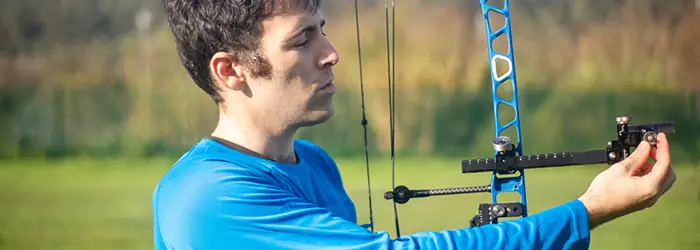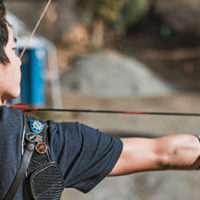A common consensus amongst most people is that archery is a difficult sport. Admittedly, mastering archery requires unmatched skills and technical ability. However, the same argument can be made about any sport or task.
Fortunately, there are archery tools and devices along the way to help you improve your archery skills. One of these tools is a bow sight. If you’re new to archery or want to improve your aiming, a bow sight is your best option. What exactly is a bow sight, and how can it help you improve your archery skills? Read on to learn more on how to use a bow sight in archery.
What is a bow sight?
An archery bow sight is a tool or device that uses pins, circles, lenses, and other markers to help archers improve their archery and targeting skills. The sight is placed in the middle of your bow and acts as a reference point for when you’re aiming. There are two main types of archery bow sights, and finding the right one for you will help you significantly improve your aim.
Types of archery bow sights
Before you learn how to use a bow sight, you need to find the right one for you. Archery bow sights are divided into two main categories. These are single pins sights and multi-pinned sights.
Single pin sights are arguably the most common and preferred by archers. As the name suggests, single pin sights have one aiming pin. By adjusting this pin, you can change the target range and improve your focus depending on the distance.
Multi-pin sights, on the other hand, have between 3 and 5 aiming pains. These sights have between 3 and 5 aiming pains. Multi-pin sights are also known as fixed pin sights, as they need to be set up before heading out to the field. Moreover, fixed pin sights are relatively harder to adjust once they’ve been set.
When setting the multi-pin sights, you have to carefully adjust different pins for varying distances. Since these sights can’t be easily altered, you need to carefully think about the distances you set them at. For instance, if you have a three-pin sight, you can set the first pin at 10 yards, the second one at 20 yards, and the third at 30 yards.
Some of the common set-ups for multi-pin sights are 20/30/40 yards, 12/20/25 yards, and 25/35/45 yards. However, it is worthwhile to note that you should set the sights depending on your archery skills, aiming ability, and the type of bow you’re using.
Most modern bows are manufactured with holes for attaching sights in mind. Nonetheless, whenever you’re attaching a sight, make sure you don’t tighten it too much as it can damage your bow. In addition, ensure you have a multi-sized Allen wrench to attach and adjust the sights.
How to use a single pin sight
As mentioned above, single-pin sights are highly preferred by most archers. Unlike fixed sights, single pin sights are more versatile and simpler to use. Moreover, because they take up less space, single-pin sights offer an uncluttered and clearer field of view.
When you’re using a single pin sight, you don’t have to worry about using the wrong pin, which can significantly deter your aim. Single pin sights are of great benefit, especially for budding archers. If you’re new to archery or have just started using single-pin sights, you should often practice to get the hang of it and improve your aiming skills.
Single pin sights are easily adjustable, meaning you can change the dial to account for the distance and yardage you want to shoot. However, a little more skill is required if you’re shooting at a moving target.
Most archers who use the single pin sight set it at the 20 to 25-yard mark. While you can change this depending on your shooting ability, prowess, and general preference, it is the ideal range to shoot at targets both nearer and further away.
If you set your single pin sight at sight, you can adjust the yardage by aiming either below or above the target. As your skills level increases, you’ll comfortably be able to shoot up to 50 yards without changing the pin from the 20 to 25-yard mark. It may take some practice, but the more you get used to shooting from set yardage, the easier it will be to adjust the distance with your eyes.
How to set up a single pin sight
Setting up a single pin sight is relatively easy as it’s just about repeating the process until you achieve your desired perfection status. First, decide on the distance you want to set your sight at. You can use the recommended yardage above, although you can also set up your preferred distance.
Next, use a rangefinder to measure the correct distance from your target. If you don’t have access to a rangefinder or other specialized tools, you can also manually measure the distance, although you should ensure you’re as accurate as possible.
Finally, aim directly at the center of the target and shoot your first arrow. Without moving or changing positions, shoot a second and third arrow for accuracy and confirmation purposes. If you followed the steps correctly, the three arrows should be pretty close to each other. After that, retrieve your arrows and repeat the process, this time, with one arrow. If you still achieve the same results, your sight is set, and you’re ready to go.
If the arrows land in different places, something is wrong. Simply start the process afresh, ensuring you are correct in each step. If this still doesn’t work, your arrows might have a problem. Use a different set of arrows to see if you achieve different results.
It is noteworthy to mention that it may take some time before you can perfectly line up your shots. Don’t be discouraged if there is some distance between your arrows and the target. Fortunately, the more you practice, the better you’ll get at hitting your target. Moreover, once you’ve nailed hitting the target with ease, you can now start manually adjusting the yardage to aim above or below your desired target.
How to use a multi-pin sight
While single pin sights are known for their versatility, their fixed pin sights are revered for their precision. As mentioned above, you can use a single-pin sight on a moving target. All you need to do is manually compensate the actual distance from how far your set target is.
Multi-pin sights, on the other hand, are great for aiming at moving targets. For example, if you’re shooting a deer that is 20 yards away, you can just use the 20-yard pin. However, if the animal moves to about 35 yards away, you can switch to the next markers and aim between the 30 and 40 markers.
The ease in using multi-pin sights is having different reference points in terms of distance. Granted, you may not have a clearer view as someone using a single-pin sight. However, this should not be a problem so long as you can tell how far the target is. The best way to use fixed pin sights is to set the target between the two closest pins and then release your shot.
How to set up fixed pin sights
With the help of your Allen wrench, adjust all the aiming pins to the centermost point. Since you’ll be firing quite several arrows, ensure you get a durable target. After that, use the rangefinder to mark every ten yards from your target and up to 40 or 50 yards.
Start by standing at the closest point about your pin. For example, if the first pin is set at the 20-yard mark, then stand 20 yards away from your marker. Like in the previous steps, aim at the center of the first pin and release your first shot. Repeat this process with your second and their arrow.
If you’re satisfied with the landing of the arrows on your target, move to the next reference point on your pin and repeat the process. After you’re done at the marked points, move to a point between to pins, like 35 yards, and prepare for your next shot. This time, aim between the two closest sights, and once you’re in the middle, release your shot. Once again, repeat this process until you’re satisfied with the results.
General tips for using bow sights
These tips will help you improve your aiming skills, regardless of the type of bow sight used.
- Maintain a consistent anchor point – When sighting your bow, ensure the point where your bowstring hand anchor is the same at full draw.
Adjusting the anchor point even slightly can give your significantly varying results.
- Split up the sighting process – while you may want to get everything done in a day, you may want to spread out your practice rounds to make sure you give yourself tie to master the different techniques and skills.
- Practice makes perfect – repeatedly hitting the target in one day is great. However, that doesn’t make you a pro archer. Ensure you repeat the process over and again to perfect your aiming skills.
Ultimately, bow sights are a great way of improving your accuracy. Learning how to use a bow sight will benefit any archer, from the greenest of beginners to the most seasoned veteran. You can try out both single-pin sights and multi-pin sights to find out which one works best for you.



